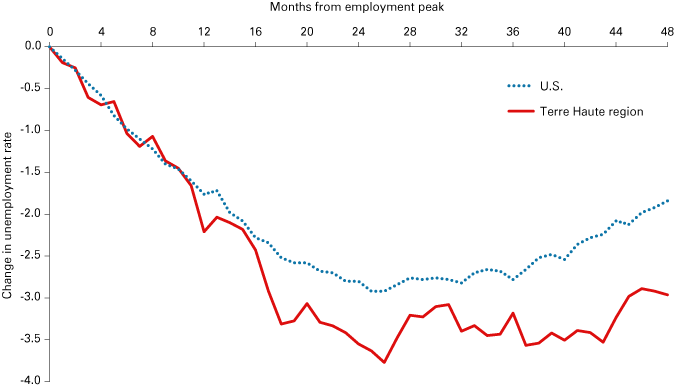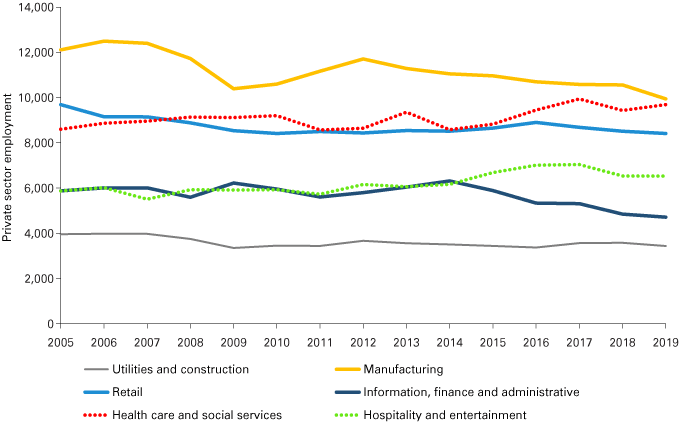Terre Haute forecast 2021

Professor of Economics, Indiana State University

Associate Professor of Economics, Rose-Hulman Institute of Technology
When it comes to timing and economics, Terre Haute seems to have had horrifyingly bad luck. Over the last 20 years, major companies have invested hundreds of millions of dollars in Vigo County only to see events seemingly conspire against them—and by extension, against the regional economy.
CertainTeed built a siding plant to feed a voracious housing market in 2007. Boral Brick did the same, utilizing cheap methane from a landfill at the same time that the housing market collapsed and natural gas prices plummeted. Pfizer invested heavily in an inhaled insulin facility only to find that there was no market for such a product. Sony DADC won a platform competition with Toshiba, positioning its Terre Haute facility as the exclusive production operation for Blu-ray discs. Instead of being a boon for the local economy, video streaming services have obliterated the market for physical media.
Given this curious history, it is perhaps ironic that a global pandemic might just lead things to work out marvelously for Terre Haute in the coming months and years. Here’s what we mean…
Had the “Rocksino” (don’t blame us, that is the name the owners of the new casino-music venue gave it) succeeded in being approved in the 2017 legislative session, it would have been built in time to open in late 2019 or early 2020. What an unmitigated disaster that would have been. Instead, having just recently cleared its final regulatory hurdle, it will be built in 2021 just in time for a vaccine to allow patrons—with their pent-up demand—to get out and enjoy themselves again.
Similarly, had Indiana State University (ISU) and the city of Terre Haute managed to agree in 2015 to incorporate the $37.5 million Hulman Center renovations into the construction of a new downtown convention center, it would likely be in its first year of operation in 2020. Instead, the negotiations stalled, ISU went its own way with Hulman Center (with renovations completed in late 2020) and construction on the city’s new convention center construction is just now getting underway.
Both the casino and the convention center projects (likely to contribute more than $150 million in construction spending) are now likely to open in late 2021, ready to greet eager patrons in a post-pandemic world. For once, the timing couldn’t be more perfect. Add to that an unexpected coup of a $40 million Veteran’s Administration clinic on the city’s east side, the construction business in Terre Haute will be peaking at exactly the time when the rest of the economy is simply trying to figure out how to operate in the midst of the pandemic. In a sense, because of this uncharacteristically good timing, construction spending will keep the local economy afloat while the economic crisis spawned by the pandemic stalls other important sectors.
Even the recession seems poised to treat the regional economy differently than past recessions. In terms of changes to the unemployment rate wrought by recessions, during recent recessions adverse effects on the Terre Haute regional economy tend to linger longer that at the national level (see Figure 1). The current recession, however, looks like it may be quite different. After a rapid and unprecedented spike in unemployment generated dark visions of an unfolding economic cataclysm in the spring, by late fall the unemployment rate, both at the national and regional levels, was falling rapidly, with the seasonally adjusted local unemployment rate actually falling faster than the national rate. It has long been taken as permanent and divine truth that Terre Haute suffers more and longer during recessions than the state and nation. That this may no longer be the case, or that this may not be the case this time, is surprisingly fortuitous.
Figure 1: Path of unemployment rate during recent recessions

Note: This graph shows the average of the 1981, 1990, 2001 and 2008 recessions.
Source: Authors’ calculations, using U.S. Bureau of Labor Statistics data
While construction of the casino and convention center will help the local economy in the short run, our assessments of these project’s longer-term benefits are divided. Both of us are skeptical of the net benefit of the casino (though we acknowledge that it will hasten the development of the southeastern corner of the city). We maintain, however, that the economic benefits arising from new restaurants and hotels that spring up along the Highway 46 corridor will be offset by those that shutter elsewhere. The city’s traditional shopping and entertainment area on South Third Street, centered on the newly renamed Haute City Center, is already facing the kinds of challenges that face brick-and-mortar retail everywhere.
With respect to the convention center, our views differ, with one of us believing it will be a key component to a revitalized downtown, while the other believes it will merely and mostly serve as an underused wedding venue. We are in lockstep, however, regarding the economic and health benefits associated with having a Veteran’s Clinic in town. The staffing required to operate the clinic will boost the local economy significantly, with the expenses picked up almost entirely by the federal government. Additionally, should the Terre Haute International Airport (also located in the same part of town) land the contract to be the foreign military training center for the F-16 and F-35, an announcement of which is due in early 2022, that would also be an enormous boon to the community. Should this occur, it would likely absorb at least a portion of the empty rental units.
In our view, these projects and the construction spending associated with them, are likely to see the regional economy through whatever economic havoc the pandemic continues to wreak. We would be remiss, however, if we did not note that these relatively fortuitous developments are taking place against the aforementioned backdrop of continuing population and employment decline. The population continues to stagnate at least in part because of a nearly 20% retrenchment in enrollment at ISU. An added feature of the present landscape arising from this retrenchment is that the city is dramatically overbuilt in terms of rental units.
For decades, Terre Haute has thought of itself as a manufacturing center, despite that retail shopping has accounted for a disproportionate amount of economic activity for many years. Now, both distinctions are more myth than reality. The regional economy continues to evolve toward health care, hospitality and education. Since the early 2000s, the region has lost about 5,000 jobs, mostly in manufacturing and retail, but also in information, finance and administration. Employment growth in health care and hospitality (hotels and restaurants) has offset about 1,800 of these losses (see Figure 2). Union and regional hospitals continue to be dominant service providers in the region.
Figure 2: The changing composition of private sector employment

Source: U.S. Bureau of Labor Statistics (Quarterly Census of Employment and Wages)
The education sector, while not contributing significantly to employment gains, continues at least to be a good source of well-paying jobs and attracts spending from outside of the community. ISU, Rose-Hulman, Saint Mary’s, and Ivy Tech’s Wabash Valley campus combine to serve nearly 20,000 students and employ many more.
Health and education are becoming the economic cornerstones of the community. Going forward, the sector most likely to replace brick-and-mortar retailing is hospitality (including the casino, hotels, restaurants, bars and the convention center). While it is relatively easy to order clothing and electronics through e-retailers, it is harder to order a gin and tonic. Hospitality will be a regionally important industry even when the shakeout of retailers is complete. Whether Zoom meetings will permanently replace face-to-face conventions like they have during the pandemic, only time will tell.
As it continues to undergo this sometimes-painful transition, Terre Haute is experiencing all of the familiar national trends. The rise of online retailing, the demise of big-box retailing, the sad crumbling of the midsize shopping mall and the inexorable decline in manufacturing employment are all familiar data points for Terre Haute. But so is the rise of health care, hospitality and services. In these respects, Terre Haute may be quite typical.
The principal challenge facing the community is how to provide the social infrastructure needed to make Terre Haute an appealing place to live and raise a family in early 21st century America. One of the unanticipated trends spawned by the pandemic, with its surge of remote work, is that of people relocating from large metropolitan areas to small and midsize cities just like Terre Haute. And while this may present an opportunity for Terre Haute, it also highlights what we feel is its greatest challenge.
As we have noted in past outlooks, the local school system (and by extension the entire community) faces an enormous challenge to rebuild its secondary schools in the not-so-distant future. In our view, the way in which the community answers that challenge will have a great deal to say about what the local economy looks like in the coming decades.



